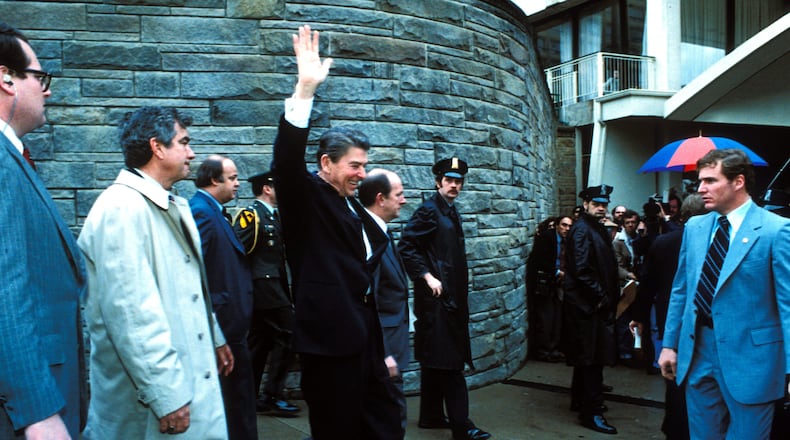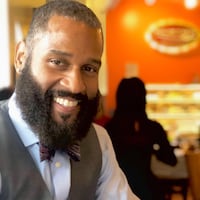Only five months after Ronald Reagan was elected the nation’s 40th president in a landslide victory, he was shot by a would-be assassin outside a Washington, D.C., hotel on this day 40 years ago.
The attempt on Reagan’s life on March 30, 1981, occurred only weeks after the tragic slaying of former Beatles front-man John Lennon in New York City on Dec. 8, 1980.
Like Lennon, Reagan was stalked by a man with severe mental illness who emerged from obscurity through the use of a handgun.
Both tragic events left the nation shaken and uncertain, but unlike Lennon, Reagan survived — along with a new era of conservatism.
Still, the attempted assassination on the nation’s new commander in chief had a lasting impact on the collective consciousness of everyday Americans, many of whom began to pressure lawmakers for tougher gun laws.
Like the assassination of President John F. Kennedy nearly two decades before, those around at the time of Reagan’s shooting recall where they were the moment they heard the news.
What happened
It was a rainy Monday afternoon. Reagan had just wrapped up a speech at the Washington Hilton Hotel, about a mile-and-a-half north of the White House, and was being spirited out of the building surrounded by his Secret Service detail.
Outside, as Reagan and his entourage approached an awaiting limousine, the new president turned to wave to a crowd of clamoring reporters when a barrage of gunfire rang out.
Credit: The Associated Press file photo
Credit: The Associated Press file photo
A 25-year-old man among the crowd — a troubled loner later identified as John Hinckley Jr. — had been waiting with a .22-caliber pistol.
A series of stunning photos taken during the unimaginable moment show Reagan lowering his arm and a smile washing away from his face before Secret Service agents abruptly shoved the president to the backseat of the presidential limousine in a matter of seconds.
The victims
Six shots were fired, leaving four men wounded, including Reagan. All survived although not unscathed.
One of the bullets had ricocheted off the limo and entered the president’s left chest, collapsing his lung.
White House press secretary James Brady, who was struck in the head, suffered permanent brain damage and was left paralyzed the rest of his life.
Credit: The Associated Press file photo
Credit: The Associated Press file photo
Timothy McCarthy, a Secret Service agent who likely saved Reagan’s life, took a bullet as he hurled himself at the gunman. He was wounded in his right lung and diaphragm before the bullet came to rest in his liver, reports said. Washington, D.C., police officer Thomas Delahanty was shot in the back, and the bullet lodged in his spine.
As the gun ran out of bullets, agents tackled Hinckley to the ground and handcuffed him.
During the chaos, one of the Secret Service agents brandished an Uzi machine gun.
Initially it was unclear whether Reagan had taken a bullet.
As the limo sped away, Secret Service agent Jerry Parr pawed underneath Reagan’s clothing, searching for wounds, but his hands emerged clean. He then noticed frothy blood coming from the president’s mouth and ordered the driver to head immediately to George Washington University Hospital.
The ‘Great Communicator’
Reagan was rushed to George Washington University Hospital, where he ultimately spent 10 days.
Throughout, the nation held its collective breath as television news rolled continuous footage of the shooting, and unsubstantiated rumors surfaced that Reagan was in danger of dying from his injuries.
But behind the scenes Reagan was positive and kept a sense of humor about his ordeal.
“I'm sorry, honey, I guess I just forgot to duck."
Reports said the president walked into the emergency room unassisted, telling aides: “Don’t worry about me, I’ll make it.”
When first lady Nancy Reagan arrived at the hospital to be by her husband’s side, Reagan reportedly said to her, “I’m sorry, honey, I guess I just forgot to duck.”
The grave nature of his situation didn’t appear to worry the president at all.
Reagan cracked jokes with doctors and nurses, at one point joshing: “If I’d gotten this much attention in Hollywood, I would never had left.”
Before going into surgery, Reagan quipped to the staff, “I hope you are all Republicans.”
Reagan’s surgery lasted more than two hours to remove the .22-caliber bullet, and although he lost 2 ½ liters of blood, he emerged in good condition.
At a news conference the morning after the shooting, doctors revealed that the president had not realized he had been shot until he entered the emergency room the day before.
“He thought he had cracked a rib. He did not equate his pain with a bullet wound,” said Dr. Denis O’Leary, who was dean for clinical affairs at George Washington Hospital at the time.
At one point during his convalescence, an aide told the president: “You’ll be happy to know that the government is running normally,” to which Reagan replied: “What makes you think I’d be happy about that?”
Ronald Reagan’s shooter
John Hinckley was from an affluent family in Dallas and was the youngest of three children.
His father was an oil man and his mother a homemaker.
A college dropout, Hinckley was desperate for fame after a failing to get a music and writing career off the ground.
By his mid-20s Hinckley began stalking actor Jodie Foster and tracked her to New Haven, Connecticut, where she was enrolled at Yale University in September 1980. By attempting to assassinate the president, he sought to fulfill a morbid fantasy to impress the actor, with whom he had developed an obsession after seeing her in the 1976 film “Taxi Driver.”
Credit: File Photo
Credit: File Photo
Hinckley reportedly slipped notes and greeting cards under the door of her dorm room, and soon he managed to get her phone number and eventually called to introduce himself. Foster, however, rejected his advances.
From there, Hinckley reportedly began to sink deeper into madness.
Reports said he used a fake ID to purchase the revolver he used to shoot the president for $29 at a pawn shop.
Before Reagan was elected, Hinckley had been arrested for possession of three concealed weapons at the airport in Nashville, where he had attended a campaign rally for Jimmy Carter and had a ticket to attend another campaign stop by the incumbent in New York, according to reports.
In 1982, Hinckley was found not guilty by reason of insanity in the shooting of the president and the three others.
Credit: Reuters / Brendan Smialowski
Credit: Reuters / Brendan Smialowski
He spent 34 years in St. Elizabeth’s Hospital, a psychiatric facility in Washington, D.C., and was released in September 2016.
From there, he went to live with his elderly mother in Williamsburg, Virginia. A judge ruled he was no longer a threat to himself or the public. Before his release, he had already been visiting his mother and staying with her for long periods of time in preparation for the transition, the AP reported at the time.
Today, he is in his mid-60s.
The fight for gun control
Brady died from his injuries in August 2014 at age 73, nearly 33 years after the shooting. His death was ruled a homicide, although Hinckley never faced additional charges.
Before Brady died, he became a symbol of the fight for gun control, championing tighter regulations from his wheelchair.
Credit: The Associated Press file photo
Credit: The Associated Press file photo
Brady and his wife, Sarah, campaigned for a bill that Congress passed 12 years after the shooting.
In 1993, the couple successfully lobbied for the Brady Handgun Prevention Act, which instituted federal background checks before purchasing firearms and prevented certain people, including felons and the mentally ill, from legal buying a gun. On Nov. 30, 1993, President Bill Clinton signed the Brady bill into law, with Brady at his side in a wheelchair. In 1994, the Violent Crime and Control Act established a federal ban on assault weapons and assault clips, but that ban was allowed to expire in 2004.
They issued statements calling for renewed restrictions after episodes including the school shooting in Newtown, Connecticut, in 2012.
In the 1990s, when he was pressing for the Brady bill, Brady dismissed as “lamebrain nonsense” the National Rifle Association’s contention that a waiting period would inconvenience law-abiding people who had reason to buy a gun. The idea behind the waiting period was to give the seller time to check on whether the prospective purchaser had a criminal record or had lied in supplying information on the required documents.
Brady said that five business days was not too much to make purchasers wait. Every day, he once testified, “I need help getting out of bed, help taking a shower and help getting dressed, and - damn it - I need help going to the bathroom. I guess I’m paying for their ‘convenience.’ "
As the Bradys worked the phones, shoring up supporters, opposition to the bill softened in Congress in the wake of a surge in gun-related violence across the nation and public opinion polls showing crime and violence to be top priorities for Americans.
Information provided by The New York Times was used to supplement this report.
About the Author
The Latest
Featured







